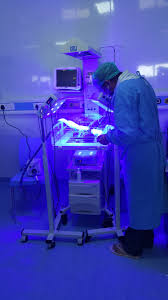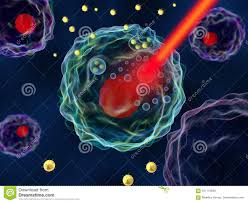
Worldwide medical community has begun using phototherapy to treat a wide variety of medical conditions. This includes psoriasis, cancer, and jaundice in infants as depicted in the image above. Courtesy of commons.wikimedia.org.
Scientists have spent many years looking at different ways of treating various types of medical conditions. This includes mental/psychological conditions such as depression, and physical ailments like cancer. However, only recently researchers began looking at phototherapy as a viable option to treat cancer and other medical conditions such as skin and oral cancer. This method does not suffer from the same problems as other treatments like surgery or radiation do. In short, phototherapy is the use of light to treat physical or mental ailments. Patients treated with phototherapy undergo exposure to different light sources like LEDs and lasers. During phototherapy, doctors use special drugs, called photosensitizing agents, along with light to selectively target and kill cancer cells. The opportunity to selectively target cancerous cells gives medical professionals the tools to treat deadly illnesses, such as cancer, more effectively and less invasively.
New Methods for Treating Skin and Oral Cancer
Recent developments prove that phototherapy can help curing skin and oral cancer in a way that other methods cannot. One example of this is the joint partnership between The Center for Process Innovation (CPI) in Wilton, England, and LightOx in Wynyard, England. The two organizations started a joint project that focuses on light-based treatments for removing skin and oral cancer cells. This includes probes that bypass the traditional problems associated with fluorescent probes.

New light therapy technologies and research into phototherapy are being used to target and destroy cancerous cells. This includes the tumors for skin and oral cancers. Image courtesy of dreamstime.com.
These new probes will simplify delivery into the cell and minimally disrupt cell activity prior to light activation. The new technology will also involve a simple delivery system that will target therapeutic action to particular body sites. This offers a lot of benefits because the delivery system will enable instant treatment and cell death of selected cells and tissues without damaging healthy cells. Therefore, the new treatment will eliminate previous side effects. Since the treatment involves targeting specific areas, there is less risk for complications such as radiation poisoning.
Phototherapy to Treat Psoriasis
As mentioned previously, phototherapy can treat more than just cancer. While doctors use phototherapy to treat many illnesses, they use it to treat psoriasis more than many other conditions. Psoriasis is a long-lasting autoimmune disease characterized by patches of abnormal skin. These patches are often dry, red, and itchy. Psoriasis can lead to other problems such as arthritis, bleeding from the skin, and swollen and stiff joints. Medical researchers have often struggled with how to effectively treat psoriasis. Many organizations focus on targeted phototherapy for treating psoriasis in areas that are hard to reach such as the scalp. This includes recent work with excimer laser holds that can lead to more aggressive, effective treatment and long-lasting remission of psoriasis. This is an effective treatment option because many patients have psoriasis symptoms in small, specific areas rather than across their entire body.

An example of a handheld phototherapy device for treating psoriasis and other medical conditions. It can be used for target specific areas where certain medical conditions are present so that complete body exposure is unnecessary. Image courtesy of commons.wikimedia.org.
However, the new handheld phototherapy technology offers many conveniences that previous phototherapy technology did not. Biomedical engineers have developed various portable and lightweight handheld phototherapy units over the last decade. These devices tend to be lighter and easier to handle than previous devices. As a result, doctors and patients use these devices to treat localized psoriasis in the office and at home. This is much better than full body treatment since this limits skin exposure to UV light and only targets the specific areas of the skin where psoriasis is a problem.
Benefits and Shortcomings of Phototherapy
Phototherapy comes with a number of benefits that other treatments for curing cancer and other conditions do not possess. For example, phototherapy does not have many of the same long-term side effects compared to other methods when used properly and it can be targeted very precisely. Furthermore, phototherapy often costs less than other cancer treatments and unlike radiation, doctors can repeat phototherapy at the same site multiple times.
Conversely, phototherapy still has its limits. Phototherapy will only work if the light can reach the targeted area or areas. Therefore, doctors mainly use phototherapy to treat problems at the surface level of the skin or just under it, or in the linings of organs. Similarly, since light can’t travel very far through body tissues, phototherapy can’t be used to treat large cancers or those that have grown too deeply into the skin or other organs. Finally, not everyone is a candidate for phototherapy, such as patients with certain blood diseases or those that that have allergies to certain phototherapy drugs.
There are a lot of potential applications that phototherapy offers along with its limits, and it will be interesting to see which direction the new technology and research heads in.

PCI Biotech of Norway is using light therapy to treat cancer in the bile ducts, and to make cancer vaccines be able to penetrate the cells:
http://pcibiotech.no/pipeline-2/